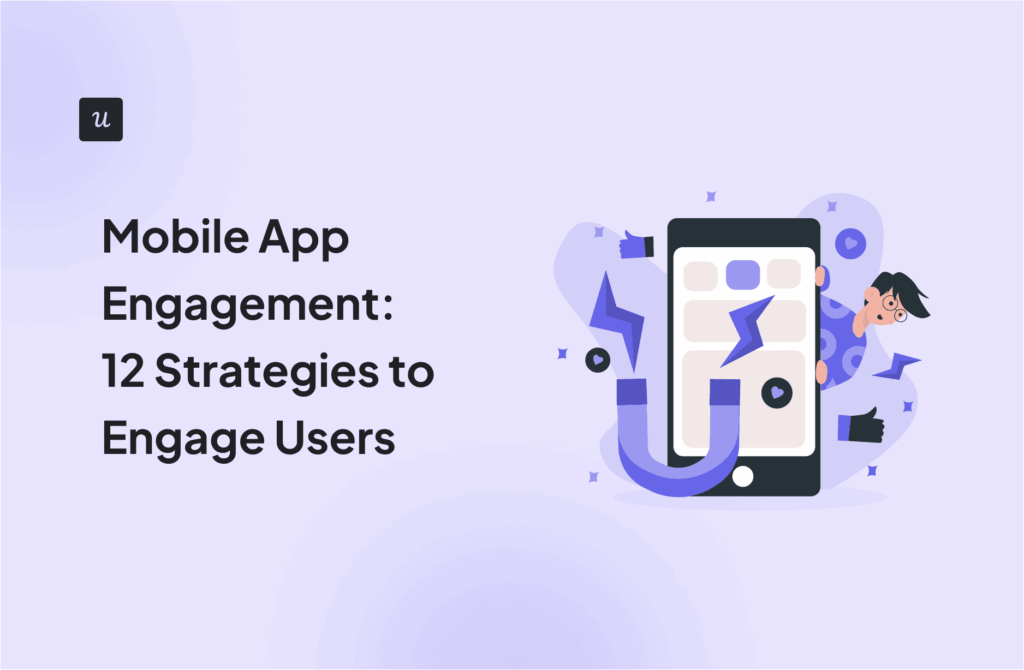
What’s product communication? Is it different from product messaging? Why is it important for your product? How can dedicated in-product communication tools help you achieve your product goals?
These are the key questions we discuss in the article, so if you’re after the answers, you’re in the right place!
Ready to dive in?
Try Userpilot Now
See Why 1,000+ Teams Choose Userpilot

Product communication guide summary
- Product communication is all the communication that helps users experience the product value, for example, in-app messages.
- Product messaging is about communicating the product value proposition to potential customers, while product communication helps you convert new sign-ups and guides the existing users through the product.
- An efficient strategy helps users overcome feature blindness and improves their confidence in using your product to drive adoption and retention.
- Start creating your product communication plan by setting actionable goals.
- Use segmentation to target specific user personas with relevant messages.
- Differentiate UI patterns based on the goals. For example, Userpilot used smaller banners and tooltips to announce webhooks but bigger modals for Resource Centre announcements. Slack used a similar approach when announcing text formatting and Huddles.
- Customize the layout, font size, and colors of your messages to make them consistent with your branding. For instance, Asana tooltip colors match those of its UI and depend on the function of the tooltip.
- Use elements of storytelling in all your communications to promote your brand and product vision and build relationships with your users. Tolstoy does it by recognizing user needs and pain points, which is reflected in its intuitive UI and customized functionality.
- Run A/B and multivariate tests to identify communication strategies that drive your goals most effectively.
- Add CTAs to your messages to prompt user engagement.
- Whether you are a senior product manager or only starting your career, Userpilot can help you design and implement your product communication strategy with product analytics, in-app messages, A/B testing, and segmentation.
- Want to see how? Book the demo!
What is product communication?
Product communication is the process of conveying all the information that your users need to use your product effectively.
This includes all the in-app guidance and messages that allow users to achieve their goals as well as support materials and documentation.
Product communication vs product messaging
Product messaging is about creating a specific perception of your product in the market. It is a part of the marketing plan that defines and communicates the value proposition of your product to your target audience so that they can decide if it’s suitable for their needs.
This is conveyed through marketing communications and delivered via different media like your website copy, paid ads, or email newsletters.
Product communication also relies on a range of channels. The difference, however, is that its main focus is providing users with the information they need to fully experience the product value.
Main benefits of proper product communication tactics
There are three main benefits of a sound product communication strategy.
For starters, it helps you combat feature blindness. That’s when your users are so preoccupied with the features they use regularly that they don’t notice others.
Why is this a problem?
In short, many of the features that your users overlook could be very essential for their use cases and help them achieve their objectives in less time.
Even if your users know about features, it doesn’t mean they know how to use them effectively.
With well-crafted in-app guidance, you can educate them and develop the right level of proficiency. And the more proficient they are, the more likely they are to stay with your product.
This takes us to the final benefit: product communication can help you boost product adoption and retention. If your users get the value they expect from your product, they’ll have no reason to look anywhere else.
Best practices for a successful product communication strategy
As mentioned, there are a number of channels that you can leverage for product communication, like email marketing.
However, as a product manager you’re probably most interested in in-app communications, so why don’t we focus on how you can best use them to drive product and business goals?
Set product communication objectives so you can measure success
Start creating your product communication strategy matrix by setting clear objectives. This not only gives you focus but also allows you to measure the effectiveness of your efforts.
What could be your goals? Some common examples include:
- boosting new feature adoption rates
- increasing the activation rate
- reducing the time to value
- improving the retention rate

Use segmentation to reach the right user personas
Effective product communication needs to be relevant.
If you bother your users with information about features or updates they don’t need, they may start ignoring the messages altogether and will miss out on the important stuff.
To avoid this problem, use user segmentation to target the right users with the right messages. For example, if your new feature is relevant for a specific user persona, trigger the in-app announcement only for these users.

Use different UI patterns for announcements based on different purposes
Modern onboarding and adoption tools offer various UI patterns you can use to communicate.
When planning your in-app communications, choose the right tool for the job.
For example, large modals are great for new feature announcements because you don’t want your users to miss them. Tooltips, on the other hand, are more suitable for announcing feature improvements and driving engagement with existing features.

Ensure brand consistency across your product communication strategy
The effectiveness of your messages depends not only on the copy but also on what it looks and feels like.
For starters, try to make your messages consistent with the rest of your UI, the landing page, logos, and other marketing assets.
Consistency across different message types is another thing worth the effort. For example, try to make all your new feature announcements look the same.

Use storytelling across all your product communication
Compelling storytelling increases the chance of your brand being remembered. Stories captivate and inspire users. They also help you communicate the product vision and build relationships with your users.
Although storytelling is normally associated with product messaging, product communication also plays an important role in spinning your narrative.
How do you do it?
First, make sure that all your UI elements, the CTA details and copy, in-app messages, and tone of voice need are in line with the story of your product.
Next, put the users in the center by focusing on their needs, keep the messages concise and jargon-free, and include elements of emotional design.

A/B test different communication strategies
A/B and multivariate testing are great ways to determine which communication strategy is most effective at driving your goals.
In Userpilot’s A/B tests, you trigger one in-app experience to half of a user segment automatically. Then sit back and watch which group (the control group that didn’t see the experience or the variant that did) increases your goal completion rate.
This way you can tell if adding an onboarding checklist helped increase your activation goal, for example.

In multivariate testing, the principle is similar.
However, the number of variables you manipulate is higher. For example, you could be testing 3 different versions of the copy, 3 different font styles, and three different sizes at the same time. That’s 27 combinations.
Prompt engagement with short Calls To Action
This one is simple. If you want your users to act, always add a CTA to give them the nudge. The easier it is to follow, the more likely they are to do it.
Want to find out how to build in-app messages with CTAs like the one below in Userpilot? Book the demo!

Product communication examples that prompt users to take action
Now that we know all the do’s and don’ts of product communication, let’s have a look at how market-leading companies apply them in practice.
Announce features by using a mix of UI patterns – Userpilot example
Userpilot is a product adoption platform, so we know a thing or two about product messaging.
One lesson we’ve learned is that when announcing new features, one in-app message is not enough. To make sure that users don’t miss a feature that could be a game changer for their use case, use a sequence of different UI patterns.
Userpilot announces a new feature through a banner
Webhooks allow you to create custom integrations with third-party apps. For example, you can set an event completion as an email trigger.
When Userpilot first introduced the feature, we announced it with a banner that included a CTA prompting users to check it out. That was the start.

Userpilot follows the announcement with a walkthrough
To reinforce the message and improve the discovery of the Webhooks feature, we backed the banner up with a tooltip.
This was triggered when users went to the Integrations page. As Webhooks were a new addition to the page, the tooltip did a great job of attracting the users’ attention.

Launch a big new feature or update with a modal
Webhooks are a valuable addition to the Userpilot functionality, but they aren’t necessarily a breakthrough feature. Unlike the Resource Center, which is a proper big deal.
For such a big launch, you want something a bit more flashy. To announce the new functionality, we used a modal.

Maintain consistency in all product communications – Asana example
As mentioned, consistency across all your messages is key to communication effectiveness.
Asana knows this very well.
Each kind of message looks exactly the same, so its users know what kind of information they can expect when it pops up on the screen.
All Asana tooltips with tips look the same. They are purple and contain a short text and a small button you can use to acknowledge the message.


While the purple tooltips are reserved for product tips, the white ones are used for notifications only. They include an icon, a short message, and a CTA button. They also always pop in the bottom left corner of your screen to avoid interruptions.

Use storytelling to address different pain points – Tolstoy example
Tolstoy is a tool that enables users to create interactive videos that can boost user interactions and drive conversions better than regular videos.
The company uses storytelling to engage its users.
How do they do it?
By empathizing with their users, showing them that they understand their users’ problems, and showcasing a solution that addresses them.
In this case, Tolstoy appreciates that creating videos can be a daunting task. That’s why they simplify the process for their users as much as possible.
One click on their welcome screen is enough to launch a ready-made video, while the more tech-savvy users still have a chance to create one from scratch.

Tolstoy templates are also a recognition of user needs and their pain points. The company knows exactly what kind of interactive videos SaaS teams may need, and has prepared a bunch of ready-to-use templates that make the job so much easier.

Adjust the size of UI patterns for different announcement types – Slack example
Slack, the instant messaging platform, varies the size of the in-app messages depending on how important the message is.
For bigger releases, Slack goes big.
For example, when they released the huddle feature, they used a slideout with basic information and a CTA.

Clicking on the CTA triggered a modal, which contained way more information about the new functionality.

For small releases, on the other hand, slack uses smaller UI patterns.
When they launched the message formatting features, they used a small tooltip to announce it. Small doesn’t mean hard to notice though. This one was GIF-based, so attracted plenty of attention.

How Userpilot helps product managers with their product communication strategy
We’ve already dropped a few hints on how Userpilot can help you implement your communication strategy, but here’s an overview of the relevant features:
Let’s start with product usage analytics.
Userpilot allows you to tag and track the usage of individual features so that you can analyze how your users engage. You can also set and track goals to analyze how your users progress toward activation and adoption.

How is analytics relevant?
They allow you to set the goals for your product communication strategy and identify the areas where you need to unleash all the fancy UI patterns to guide your users.
Talking of UI patterns, there are four basic ones available in Userpilot.

These are tooltips, modals, slideouts, and driven actions. You can trigger them individually, for example, to announce a new feature, or create interactive flows for user onboarding.
If you want to run experiments to choose the best versions of your in-app messages, you’re covered too! Userpilot allows you to A/B test in-app experiences to see which drives the best results. You can also onboard and engage mobile app users by creating personalized messaging, push notifications, and surveys.
To make your marketing messages relevant, you can use Userpilot’s advanced user segmentation functionality. For example, if the new feature is particularly important for one particular user persona, you can trigger it just for them.

Conclusion
Product communication enables users to experience product value in less time. That’s because it helps them discover the features they need and educates them on how to take the best advantage of them to realize their goals.
If you want to see how Userpilot can help you develop and implement your product communication strategy, book the demo!







